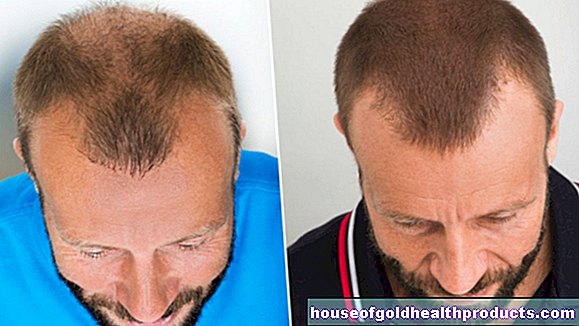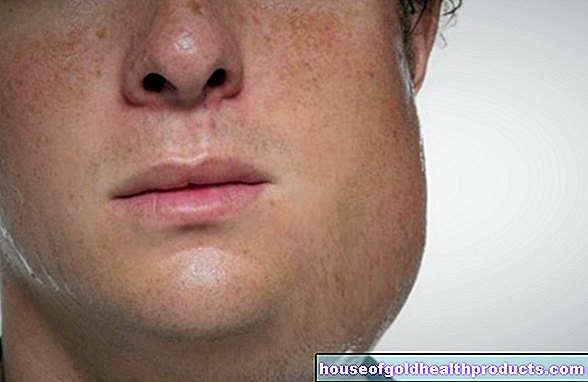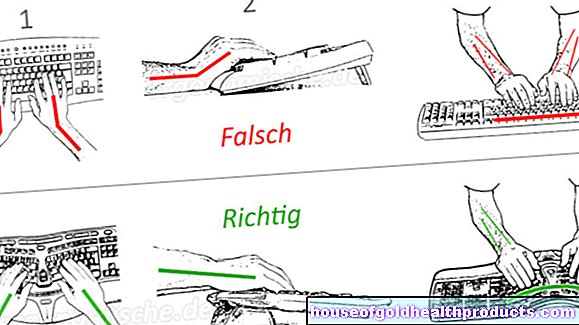Shoulder dislocation
Carola Felchner is a freelance writer in the medical department and a certified training and nutrition advisor. She worked for various specialist magazines and online portals before becoming a freelance journalist in 2015. Before starting her internship, she studied translation and interpreting in Kempten and Munich.
More about the experts All content is checked by medical journalists.Shoulder dislocation or shoulder joint dislocation means that the affected person has dislocated their shoulder. The bone head of the upper arm is no longer in the socket. A dislocation of the shoulder is the most common type of dislocation. Find out here how to provide first aid for a shoulder dislocation, why you need to see a doctor and how he or she treats the dislocation.
ICD codes for this disease: ICD codes are internationally recognized codes for medical diagnoses. They can be found, for example, in doctor's letters or on certificates of incapacity for work. S43

Brief overview
- What to do in the event of a shoulder dislocation? Immobilize, cool if necessary, take affected person to a doctor or call an ambulance
- Shoulder dislocation risks: bruises or tears of nerves, ligaments, tendons, restricted mobility
- When to the doctor Always - any shoulder dislocation should be assessed and treated by a doctor.
Caution!
- As a first aider, make sure that the dislocated shoulder is neither moved nor strained.
- Never try to straighten a shoulder joint that has jumped out yourself! You could tear or pinch nerves, ligaments, or blood vessels, making the injury worse! Manual adjustment requires a lot of experience and should only be carried out by a doctor.
- If you want to cool the dislocated shoulder with ice or a cool pack, you should make sure that there is always a layer of fabric between the cooling element and the skin.
- A shoulder dislocation restricts the range of motion. If left untreated, incorrect loads and joint wear (osteoarthritis) can develop.
Shoulder dislocation: what to do?
Sometimes a fall is enough and the person in question has dislocated his shoulder. What to do about this very painful joint injury? Experts recommend the following measures for first aiders:
- If possible, remove tight clothing around the shoulders. Dislocations often swell significantly. The pressure of the tightly stretching clothing then often exacerbates the pain.
- Calm down the victim.
- The person concerned will instinctively assume a posture in which the pain is not quite as severe. Support this gentle posture and do not force him into a position that may be more uncomfortable for him.
- Stabilize the dislocated shoulder. It is best to ask the person affected to hold the arm themselves. Alternatively, you can stabilize the arm with a bandage or a triangular shawl. In addition, you can slide a cushion between your torso and arm as a support.
- Cool the shoulder area. This can relieve the pain and counteract (further) swelling of the tissue.
- Take the patient to the doctor immediately or call the ambulance!
Shoulder dislocation: risks
If the shoulder is dislocated, the affected person usually has severe pain and can barely move their arm. A bruise often forms on the shoulder and the area swells.
When the joint surfaces forcibly diverge as part of the shoulder dislocation, surrounding structures can be injured. Ligaments and vessels can tear, nerves damaged, and bones broken. Examples:
- The anterior shoulder dislocation can lead to a so-called Bankart lesion. The joint lip, a bulge-like thickening of cartilage on the anterior edge of the joint socket, partially tears off. This increases the likelihood of new dislocations.
- If a nerve running in the immediate vicinity of the shoulder joint is injured by the dislocation, this can disturb the sense of feeling at the shoulder or cause it to fail completely. Depending on which nerve is affected, the patient may no longer be able to lift the arm sideways.
- The shoulder dislocation can injure the armpit artery, which supplies blood to the shoulder muscles, among other things.
- If the affected person can no longer or hardly bend the forearm and turn it outwards, the tendon of the biceps upper arm muscle is probably trapped or torn off.
A single shoulder dislocation usually heals completely. If a shoulder dislocates frequently, the structures around the shoulder and thus the shoulder joint become more and more unstable. Persistent complaints then threaten.
Shoulder dislocation: when to see a doctor?
If someone has dislocated their shoulder, you must always take them to the doctor. Every shoulder dislocation is an emergency! The doctor can determine the severity of the injury and expertly adjust the joint again. Surgery may also be necessary.
Shoulder dislocation: medical examinations
The doctor will first examine the patient. He can often feel the empty socket and the joint head in its dislocated position at the shoulder joint. In addition, the bony shoulder roof protrudes, which makes the shoulder contour appear angular.
If the doctor tries to gently guide the dislocated arm back into its natural position, it will snap back into the wrong posture when it is released. This phenomenon is called "resilient fixation". It occurs with many dislocations.
The doctor will also check how flexible your shoulder and arm are. In addition, he pays attention to indications of accompanying injuries, as they often accompany a shoulder joint dislocation. These can be sensory disturbances (due to injured nerves) or circulatory disorders (in the case of vascular injuries).
Imaging examinations
An X-ray is indispensable to determine with certainty whether a shoulder dislocation and accompanying injuries are present. Soft tissue injuries such as damage to tendons, ligaments and cartilage can be detected using magnetic resonance imaging (magnetic resonance imaging, MRI).
In rare cases, an arthroscopy is also necessary. The doctor inserts fine optical instruments directly into the joint and can examine it more closely.
Shoulder dislocation: treatment by the doctor
A shoulder dislocation is a surgical emergency room case. The more time passes before treatment, the more serious the consequences of any accompanying injuries can be.
Basically, a shoulder dislocation can be treated with surgery or manual straightening. Which procedure makes more sense depends on the extent and severity of the injury.
Shoulder dislocation: surgery
A shoulder dislocation is usually operated on if there are accompanying injuries or other complications that cannot be treated otherwise. For example, torn ligaments, Bankart lesions and dislocation fractures are usually treated with surgery. The doctor can also tighten the overstretched ligaments. This lowers the risk of new dislocations.
Adjustment without surgery (closed reduction)
If the shoulder is dislocated, the doctor can adjust it manually under favorable conditions. This can be done using various maneuvers. Examples:
- In the Arlt maneuver, the patient sits sideways on a chair and lets the dislocated arm hang over the padded backrest. By pulling the arm lengthways with the elbow bent, the doctor tries to gently straighten the arm.
- In the Hippocratic maneuver, the patient lies on his back. The doctor presses his heel into the armpit of the patient as an abutment and pulls his dislocated arm outwards and outwards.
Before manual straightening, the patient is given a strong pain reliever. Often the doctor will also give the affected person a local or even general anesthetic.
Prevent shoulder dislocation
The most effective means of preventing a (renewed) shoulder dislocation is an even build-up and coordination training of the shoulder muscles. A strong supporting apparatus gives the joint more stability. This is especially important if you have already dislocated your shoulder. Exercising regularly can reduce the risk of shoulder dislocation again.
Tags: pregnancy birth foot care healthy feet




























